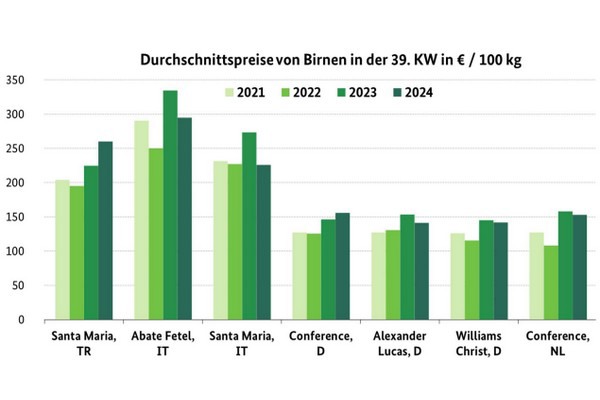Turkish pears of the Santa Maria variety predominated. Italian Santa Maria and Abate Fetel followed in terms of importance, as well as domestic Conference. Alexander Lukas, Williams Christ and Xenia also arrived from Germany. Italy rounded off the range with Williams Christ and Carmen, the Netherlands with Conference and large Xenia. While demand for the more expensive Conference from the Netherlands was limited in Munich, Turkish Santa Maria was sold steadily and at stable prices, according to BLE.

All in all, the well-measured European supplies were able to meet the demand sufficiently, with sales often falling short of expectations. Nevertheless, the valuations rarely had to be corrected downwards, mostly remaining at the previous week's level. In Hamburg, domestic Alexander Lucas and Forelle were quoted at between €1.30 and €1.50 per kilo. Kaiserkronen/Bocs Flaschenbirne are due to arrive there shortly. Köstliche von Charneux, also known as the Bürgermeisterbirne, supplemented the offerings in Cologne and Hamburg on a day to day basis, either in a layered or loose presentation.
Click here for the full market and price report.
Apples
The range continued to diversify, with domestic fruit playing the main role. Numerous varieties were available, with Elstar, Delcorf, Boskoop, Royal Gala and Jonagold forming the basis of the product range.
Table grapes
Italian seedless varieties, especially IFG and Sugra varieties, shared the market with Italia and Turkish Sultana and Crimson Seedless. Seedless large varieties from Italy were able to impress with their organoleptic properties, so their sometimes high prices changed only marginally.
Plums
The end of the season is approaching: deliveries were limited, quality slowly declined and a certain degree of customer saturation could not be denied.
Lemons
On the wholesale markets, deliveries of the new Spanish Primofiori were sluggish, so the South African Eureka were still called upon with high demands.
Cauliflowers
Domestic origins with the relatively small flower remained the dominant products on the market, with Dutch, Belgian and, in Berlin, Polish lots supplementing the supply.
Cucumbers
Domestic cucumbers dominated ahead of Dutch cucumbers. Overall, the domestic season was slowly approaching the home stretch, and in some cases not all sizes were available. Spanish lots had caught up with the Belgian batches in terms of volume and were putting significant pressure on the previous price structure.
Tomatoes
Belgian and Dutch deliveries predominated. The first Turkish vine tomato deliveries were selectively available at the weekend, which were gladly accepted at slightly lower prices. All in all, availability was somewhat limited and led to price increases in most cases.
Sweet peppers
The assortment continued to be broadly diversified. Dutch lots still predominated. However, they were gradually replaced by Spanish deliveries. Turkish, Polish and some Belgian shipments completed the picture.
Source: BLE
